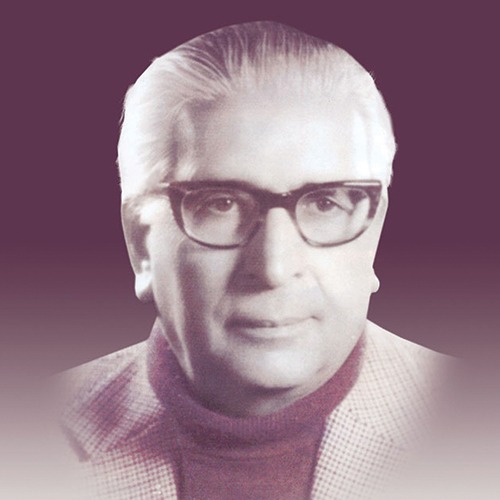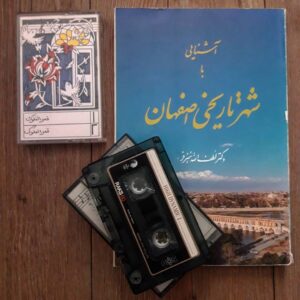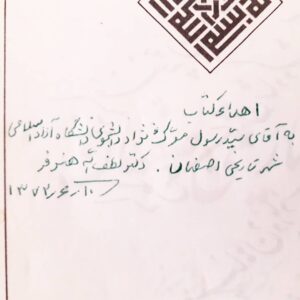
Professor Lotfollah Honarfar (1986-1919)
One of them is the song “Javani” that Hossein Ghavami (Fakheteh) performed and is recorded on a black cassette tape, labeled RAKS60, a gift from Lotfollah Honarfar (1986-1919). I first learned of Honarfar’s name from our art history teacher at the art school, and I was lucky enough to attend two semesters of art history with him at university circa 1992-1993. He was elderly but had a prodigious memory. After class, I served as his amirzabanevis (scribe) for a quick moment. I would go to his house on Mojmar Street for a few hours in the evenings. He would talk and give me references, and I would write it down. As he often said, “Your handwriting doesn’t need to be typed.” They were preparing the book “The Treasure of Historical Works means of Isfahan” for reprinting for the municipality of Isfahan, but there were issues about terms, especially regarding the refusal to remove the name of the Shah by the Shah Mosque.
He lived on Mojmar Street. Walking into Professor Honarfar’s house and going up a few steps, I reached a wide space of about six by six meters. In the center of this space was a long table with two wooden chairs on either side. I’d take notes as we would converse. At times he would say sugar is good for the brain, and I should eat chocolate. I was obedient, like a little boy before his daddy. Whenever they felt tired, he asked his wife to have some refreshments. After a little joking, Professor Honarfar would show up with a tray holding a glass of syrup. On the right side, the north end of the house, a few steps descended into the living room. The walls were lined with black-and-white photos in tarnished frames, a handful they introduced me to. In one picture, girls from the distant past surrounded by their students. They seemed to know what I was going to ask, and they explained, “I married late. I had to take care of all my siblings when my father passed, while I myself was still in school. So I studied while working. Once all of them were settled in their own homes, I thought to get married.”
Being an archaeologist, he inscribed unto me “An Introduction to the Historical City of Isfahan,” the first gift he presented me. A few weeks later he presented me with the cassette of Ghavami. “This Tasnim is my experiences,” he said, introducing the work with warmth. It was an irreplaceable gift, one borne of his deep generosity in parting with a lifetime of experience.Classic. The Tasnim of youth, written in the Dastgah of Afshari, is performed by the voice of Hossein Ghavami (Fakhteh) and with Ismail Nobar Safa, developed by Hossein Yahaghi. This particular piece was made in the years 1948-1949. The lyrics express:
“O youth, you escaped my hold,
I sit here in this bubble of sorrow;
Where are you, youth? Why did you depart?
For I tried to bear the pangs of separation and the wounds of parting.”
The writing went on for close to two months. Then, for reasons I won’t pretend to understand, I could not be in his presence and our meetings stopped. It looked like the book had run into trouble getting published.
The municipality had installed several half-ton cement planters on the bridges at that time. Honarfar was outraged, shouting, “They are destroying the bridges!” He owned a Peykan car. Every morning, one of the students would pick him up for a drive around the town, seeing the bridges and Naqsh-e Jahan Square, before heading home. He would reminisce during class, explaining how he had been offered professor jobs in countries abroad but never agreed to leave Isfahan. Therefore, he would urge us also, saying, “You should go abroad; it will make your language, and your dance, better.” Between 1952 and 1960, he was the director of the Isfahan Archaeological Department. He was also a member of the International Society of Iranian Studies, the National Heritage Society and the Council for the Protection of Historical Monuments of Isfahan.
A major part of Dr. Honarfar’s work is the book “Treasure of Historical works of Isfahan,” which was also his doctoral thesis. In it, he collected detailed descriptions of the historical works of the city and around it, and is among the most comprehensive books written about historical buildings of Isfahan. I had hoped to visit Honarfar a few times but kept putting it off until it was too late. On December 9, 2006, Professor Honarfar passed away and was laid to rest in the section of distinguished individuals in the Reza Garden in Isfahan.

